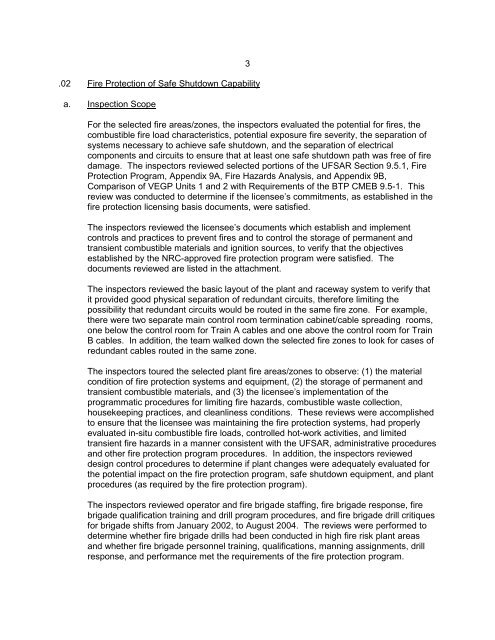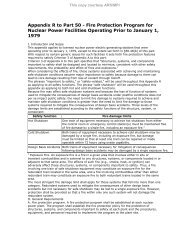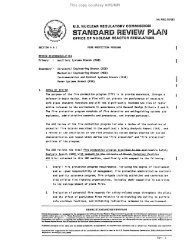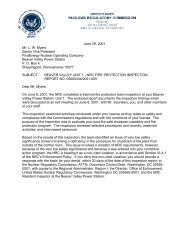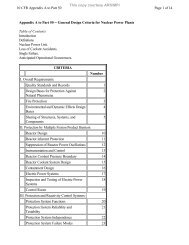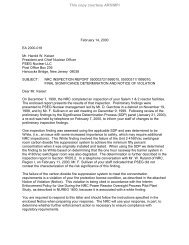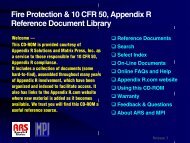Vogtle - AppendixR.com
Vogtle - AppendixR.com
Vogtle - AppendixR.com
Create successful ePaper yourself
Turn your PDF publications into a flip-book with our unique Google optimized e-Paper software.
.02 Fire Protection of Safe Shutdown Capability<br />
a. Inspection Scope<br />
3<br />
For the selected fire areas/zones, the inspectors evaluated the potential for fires, the<br />
<strong>com</strong>bustible fire load characteristics, potential exposure fire severity, the separation of<br />
systems necessary to achieve safe shutdown, and the separation of electrical<br />
<strong>com</strong>ponents and circuits to ensure that at least one safe shutdown path was free of fire<br />
damage. The inspectors reviewed selected portions of the UFSAR Section 9.5.1, Fire<br />
Protection Program, Appendix 9A, Fire Hazards Analysis, and Appendix 9B,<br />
Comparison of VEGP Units 1 and 2 with Requirements of the BTP CMEB 9.5-1. This<br />
review was conducted to determine if the licensee’s <strong>com</strong>mitments, as established in the<br />
fire protection licensing basis documents, were satisfied.<br />
The inspectors reviewed the licensee’s documents which establish and implement<br />
controls and practices to prevent fires and to control the storage of permanent and<br />
transient <strong>com</strong>bustible materials and ignition sources, to verify that the objectives<br />
established by the NRC-approved fire protection program were satisfied. The<br />
documents reviewed are listed in the attachment.<br />
The inspectors reviewed the basic layout of the plant and raceway system to verify that<br />
it provided good physical separation of redundant circuits, therefore limiting the<br />
possibility that redundant circuits would be routed in the same fire zone. For example,<br />
there were two separate main control room termination cabinet/cable spreading rooms,<br />
one below the control room for Train A cables and one above the control room for Train<br />
B cables. In addition, the team walked down the selected fire zones to look for cases of<br />
redundant cables routed in the same zone.<br />
The inspectors toured the selected plant fire areas/zones to observe: (1) the material<br />
condition of fire protection systems and equipment, (2) the storage of permanent and<br />
transient <strong>com</strong>bustible materials, and (3) the licensee’s implementation of the<br />
programmatic procedures for limiting fire hazards, <strong>com</strong>bustible waste collection,<br />
housekeeping practices, and cleanliness conditions. These reviews were ac<strong>com</strong>plished<br />
to ensure that the licensee was maintaining the fire protection systems, had properly<br />
evaluated in-situ <strong>com</strong>bustible fire loads, controlled hot-work activities, and limited<br />
transient fire hazards in a manner consistent with the UFSAR, administrative procedures<br />
and other fire protection program procedures. In addition, the inspectors reviewed<br />
design control procedures to determine if plant changes were adequately evaluated for<br />
the potential impact on the fire protection program, safe shutdown equipment, and plant<br />
procedures (as required by the fire protection program).<br />
The inspectors reviewed operator and fire brigade staffing, fire brigade response, fire<br />
brigade qualification training and drill program procedures, and fire brigade drill critiques<br />
for brigade shifts from January 2002, to August 2004. The reviews were performed to<br />
determine whether fire brigade drills had been conducted in high fire risk plant areas<br />
and whether fire brigade personnel training, qualifications, manning assignments, drill<br />
response, and performance met the requirements of the fire protection program.


